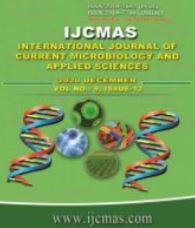


 National Academy of Agricultural Sciences (NAAS)
National Academy of Agricultural Sciences (NAAS)

|
PRINT ISSN : 2319-7692
Online ISSN : 2319-7706 Issues : 12 per year Publisher : Excellent Publishers Email : editorijcmas@gmail.com / submit@ijcmas.com Editor-in-chief: Dr.M.Prakash Index Copernicus ICV 2018: 95.39 NAAS RATING 2020: 5.38 |
An important fragrant flower crop grown in Madurai region is Jasminum sambac cv. Ramanathapuram Gundumalli. To study the postharvest quality of flower fragrance, physiological changes such as moisture content, relative water content, electrolyte leakage, flower petal thickness, changes in flower petal colour, total carbohydrate and total phenol content were studied at three flower developmental stages S1 (tight bud stage), S2 (half-opened flower stage) and S3 (fully-opened flower stage). Results on the present study revealed marked decline in moisture content, relative water content and petal thickness from S1 (84.52 %, 56.28 % and 0.34 mm) to S3 (47.67%, 45.07 % and 0.20mm) respectively. The chromatic parameters like lightness, hue and chroma indicated the whiteness of flower petal during S1 and reduction in brightness on flower opening. Electrolyte leakage, total carbohydrate and total phenol increased during S3 (57.46 %, 61.71 mg/g and 1.49 mg/g) respectively. These criteria are considered for further studies on essential oil extraction.
 |
 |
 |
 |
 |